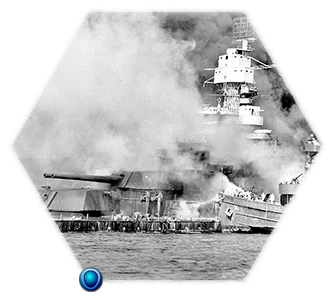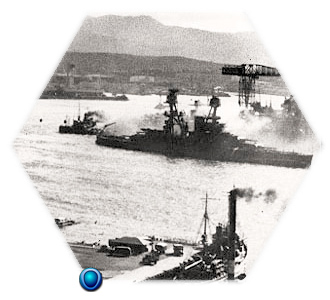By 0830, the first attack wave had spent itself. A lull
settled over the island as men on the ground prepared for more attacks. Some
American pilots managed to fuel and arm a few surviving P-40 fighters and get
them into the air. Fuchida was still airborne over the harbor, recording
observations and waiting for the last stragglers of the first wave to complete
their work. He was still there when Lt. Commander Shigekazu Shimazaki led the
167 aircraft of the second attack wave into the air over Oahu (Fuchida returned
to Akagi with dozens of shrapnel holes in his plane). The second wave
left their carriers about an hour after the first wave, and included additional
dive bombers tasked with striking warships, and high level bombers assigned to
bomb air fields. First to be hit was the air station at Kaneohe, followed
quickly by Bellows Field, and then Pearl Harbor itself. Again dive bombers
swept in from the east (the direction of the prevailing winds), bombing the
dockyards and moored ships which had escaped the first wave's attention.
Almost as the second wave arrived, there occurred a sight which both
Americans and Japanese agreed was the most stirring of the day; Nevada,
which had been working up extra boiler pressure for 50 minutes, slowly backed
out of her mooring position on battleship row. Nearly crashing through a dredge
line behind her, she slowly twisted left out into the channel without the aid
of tugboats. Then, as the second wave arrived, all 34,000 tons of battleship
slowly picked up speed at she moved down the channel past the blazing
Arizona. The effect was electric. From miles away people could see the
"tops" of the Nevada moving across the harbor. From the hills nearby
witnesses had a clear view as one of the battleships made a run for the sea.
From across the harbor, men saw the U.S. flag swinging from the stern of the
largest ship to get underway during the attack. To the Japanese, the sight was
no less stirring. They had been told that the best opportunity would come if
any large ships attempted to run for the open sea. If that happens, they were
told, sink that vessel in the main channel and you will paralyze the whole
American fleet for months. So the stage was set for a vicious attack which was
not long in coming. As Nevada cleared into the channel, groups of dive
bombers descended on her, scoring several hits. After several more minutes she
approached the narrow gap between the floating dry-dock and the dredge
Turbine, when yet another wave of bombers crashed down on her. This last
attack brought her damage total to five direct bomb hits in
 addition to the
original torpedo hit she had suffered during the first wave. As she passed down
the channel, the signal tower above the docks communicated the final word on
the issue of escape for Nevada. The signal flags read "Stay clear of
channel." Orders were orders, so after squeezing past the dredge, Nevada
was gently grounded in the mud off Hospital Point. addition to the
original torpedo hit she had suffered during the first wave. As she passed down
the channel, the signal tower above the docks communicated the final word on
the issue of escape for Nevada. The signal flags read "Stay clear of
channel." Orders were orders, so after squeezing past the dredge, Nevada
was gently grounded in the mud off Hospital Point.
Throughout
Nevada's sortie, more dive bombers arrived in the skies over the Harbor
area. Unlike the first wave which were given fairly specific targets, the dive
bombers of the second wave had free rein to choose warship targets of
opportunity. Groups of them circled high over the harbor, choosing warships
which appeared valuable yet undamaged. The dockyards and main dry-dock came
under some of the heaviest pressure. Moored in the main dockyard area were
numerous cruisers and destroyers. Immediately south of 1010 Dock was Dry-dock
Number One, which held the U.S. Pacific Fleet's flagship Pennsylvania.
This battleship, which was the sister ship of Arizona, sat high and dry
on stocks, with two destroyers, the Cassin and Downes, perched
immediately forward of her. All of them had armed during the first wave, so
once they attracted the attention of the second wave's dive bombers, they were
able to send up a fairly dangerous curtain of flak. Pennsylvania was
only struck by one bomb, but Cassin and Downes were totally
destroyed by bombing and fires. The destroyer Shaw, in the nearby
floating dry-dock was also a highly visible target, and before long she too was
in flames.
By the end of the second wave, areas other than Kaneohe and
Pearl Harbor had been raided again. Wheeler and especially Hickam Field were
subjected to further strafing and bombing attacks. The installations and
aircraft hangars at Hickam Field were some of the final target areas for
Shimazaki's high level bombers, as were the hangars at Ford Island. Dozens of
other places and ships suffered dive bomb and strafing attacks including the
tender Curtiss, the cruiser Raleigh (already torpedoed during the first wave)
and several destroyers who managed to sortie during the attack. The later often
had to run a gauntlet of strafing fighters, drifting wreckage, floating sailors
and burning ships.
By 0930 the attacks were giving way to
sporadic strafing. Fires on board Shaw finally reached her forward
magazines, disintegrating the entire front of the ship in one of the most
dramatic (and most photographed) events of the day. Over at the dockyard the
cruiser St. Louis backed out of her berth next to Honolulu and
quickly violated the harbor master's usual speed limit. Once clear of the
docks, she reversed her engines and quickly worked up to 20 knots, smashing
through the dredging line which connected Turbine to Ford Island before
speeding out to sea through the main channel.
It was 0945 before
the last of the strafing planes left for their rendezvous point northwest of
Oahu. The survivors of the attack were left to fight fires, tend the wounded
and prepare for an invasion which all were sure would come. The anticipated
invasion never came, but the fires at Pearl Harbor burned for days, and navy
engineers were salvaging wrecked ships for years. On board the Japanese task
force Admiral Nagumo and his staff nervously awaited Fuchida's attack report,
uneasy about the inevitable debate about whether or not to retire and sail back
to Japan. Once all of the aircraft were retrieved, those fit for duty (74
returning planes were damaged) were re-armed for an possible carrier action.
The men were issued fresh cakes and tea, and after talking with his flight
leaders Fuchida met briefly with Genda, Nagumo and the staff. Even then it was
apparent that Nagumo intended to keep to the letter of his orders, and Fuchida
was dismissed after a quick description of the attack. Sometime after this
briefing, the orders on Akagi went out: "Preparations for attack
canceled." There would be no follow up attack, and no hunt for the undamaged
American carriers. Fuchida stormed onto the bridge of
Akagi to complain but to no avail. Nagumo "felt like a man who had
staked his fortune on the turn of a card" and he had no intention of tempting
fate. So fortunately for the United States, the aggressive plans formulated by
Genda and Fuchida were shelved. These included plans for tracking down and
destroying the American carriers they knew must be nearby, plans for bombing
the fuel tank farms at Pearl Harbor, and plans for destroying the repair shops
known to be among the surviving dockyard buildings. Fuchida was so incensed
about the withdrawal that he refused to speak with Nagumo for the rest of the
return voyage. Fuchida stormed onto the bridge of
Akagi to complain but to no avail. Nagumo "felt like a man who had
staked his fortune on the turn of a card" and he had no intention of tempting
fate. So fortunately for the United States, the aggressive plans formulated by
Genda and Fuchida were shelved. These included plans for tracking down and
destroying the American carriers they knew must be nearby, plans for bombing
the fuel tank farms at Pearl Harbor, and plans for destroying the repair shops
known to be among the surviving dockyard buildings. Fuchida was so incensed
about the withdrawal that he refused to speak with Nagumo for the rest of the
return voyage.
Back in Japan, Rear Admiral Matome Ugaki wrote "Last
night a telegram came in that the task force was withdrawing . . . not without
being criticized as the quick pace of a fleeing thief and also as being
contented with a humble lot." It should be remembered however, that most of the
attack planning failed to consider the possibility of complete and total
surprise, which left the task force commanders with too many marginal options.
Ironically, nothing the Japanese could have done would have prevented the
inevitable. The American war machine was so immense compared to Japan's local
industries, that even the greatest successes would only have delayed the war's
end. Almost everything, from Japan's selective (and slow) process of pilot
training, to their methods of intelligence assessment (too often based on
wishful thinking) impeded their ability to force any kind of successful
negotiations.
Considering the overall war program, the final tally of
destruction at Pearl Harbor was surprisingly light, proving Genda's opinion
that the shallow harbor would facilitate repairs. Only two American battleships
were permanently lost, and of the eight present during the attack, four were
armed and at sea within two weeks of the attack. One senior U.S. officer later
commented that really, all that happened on Oahu was that the Japanese bombed a
bunch of "old equipment." Considering the galvanizing effect the attack had on
American public opinion, the end results were not really worth the enormous
risk. This was recognized even by many Japanese officers and pilots. One pilot
later captured the paradox of Japan's victory in battle with the blackly ironic
quip that maybe the U.S. Government should also have given medals to them as
thanks for their help in the mobilization effort.
|


